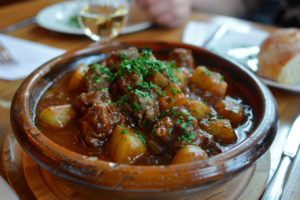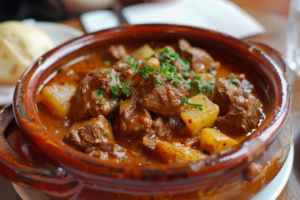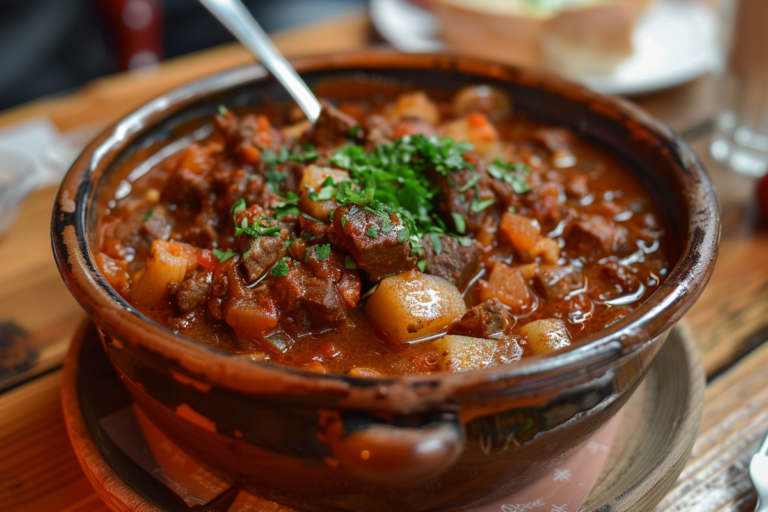Discover the Perfect Pairings for Hungarian Goulash
Hungarian goulash is not just a dish; it’s a hearty embrace from Hungary’s rich culinary tradition. As a beloved stew known globally, it combines tender beef, robust spices, and a thick, savory sauce. But what truly elevates a serving of goulash? The answer lies in its accompaniments. This article explores the myriad of sides that complement the complex flavors of Hungarian goulash, ensuring every spoonful is as delightful as the culture from which it hails.
Traditional Hungarian Goulash Recipe
Hungarian goulash, a staple in Eastern European cuisine, is celebrated for its deep flavors and comforting warmth. Let’s start by mastering the classic recipe that serves as the foundation for countless meals across Hungary and beyond.
The Heart of Hungarian Cuisine
Name: Classic Hungarian Goulash
Summary: A rich and hearty stew, Hungarian goulash is a quintessential dish that combines slow-cooked beef with a paprika-laden broth, embodying the soul of Hungarian cooking.
Servings: 4
Advanced Servings: Easily doubled to serve 8 for larger gatherings.
Prep Time: 15 minutes
Cook Time: 2 hours
Custom Time Label: Optional Marinating Time
Custom Time: 2 hours (optional, for enhanced flavor)
Total Time: 2 hours 15 minutes (or 4 hours 15 minutes with marinating)
Categories:
- Courses: Main course
- Cuisines: Hungarian
- Keywords: Goulash, Hungarian stew, comfort food
Equipment: - Amount: 1
- Name: Dutch oven
- Notes: A heavy-bottomed pot is essential for even cooking and flavor development.
Ingredients: - Amount and Unit: 2 lbs, 1 cup, 2 tsp
- Name: Beef chuck, onions, sweet paprika
- Notes: Use Hungarian paprika for authenticity; adjust onion quantity based on preference.
Instructions:
- Brown the beef in batches to ensure a rich sear.
- Sauté onions until golden, then add paprika, stirring quickly to prevent burning, unlocking its vibrant color and aroma.
- Return beef to the pot, cover with water, and simmer until tender, about 2 hours.
- Metadata for Google: Traditional Hungarian goulash recipe, how to make authentic goulash
Nutrition: - Calories: Approximately 600 kcal per serving
Notes: - For a thicker stew, allow it to simmer uncovered for the final 30 minutes. Add a pinch of caraway seeds for an authentic flavor twist.
By starting with this traditional recipe, you set the stage for exploring the various sides that can accompany this beloved dish, enhancing your goulash experience with every bite.
Recommended Side Dishes for Hungarian Goulash
When serving Hungarian goulash, the choice of side dishes can enhance or overshadow this hearty stew. The right accompaniments should complement the rich, paprika-infused flavors without competing with them. Here are some classic and contemporary sides that pair beautifully with goulash.

Bread and Dumplings: The Traditional Favorites
Bread and dumplings are perhaps the most traditional accompaniments for Hungarian goulash. Their mild flavors and soft textures make them perfect for soaking up the delicious, spicy sauce.
Table: Traditional Bread and Dumpling Pairings
| Side Dish | Description | Why It Works |
|---|---|---|
| Crusty Bread | Thick, hearty slices of rustic bread. | Ideal for sopping up the rich sauce. |
| Nokedli | Small, egg-based Hungarian dumplings. | Adds a delightful texture contrast. |
Vegetables and Salads: Light and Refreshing Options
To balance the heaviness of goulash, fresh vegetables and crisp salads provide a refreshing contrast. These sides introduce a crisp texture and vibrant flavors to the meal.
Table: Vegetable and Salad Pairings
| Side Dish | Description | Why It Works |
|---|---|---|
| Cucumber Salad | Thinly sliced cucumbers in a vinegar dressing. | Offers a cool, tangy counterpoint to the warm stew. |
| Roasted Peppers | Bell peppers roasted and seasoned lightly. | The sweetness complements the savory goulash. |
Modern Twists: Creative and Contemporary Sides
While traditional sides are always a hit, contemporary dishes can also pair well with goulash, offering a modern twist to this classic meal.
Table: Contemporary Side Dish Ideas
| Side Dish | Description | Why It Works |
|---|---|---|
| Garlic Mashed Potatoes | Creamy potatoes with a hint of garlic. | The creaminess and garlic enhance the goulash flavors. |
| Quinoa Salad | Quinoa mixed with vegetables and a light dressing. | Adds a healthful, hearty element without overwhelming the main dish. |
By choosing the right side dishes, you can create a balanced and satisfying meal that honors the traditional flavors of Hungarian goulash while incorporating elements that cater to modern palates. Whether sticking with classic bread and dumplings or opting for lighter vegetables and innovative salads, the perfect side can make your goulash dinner a memorable one.
Modern Twists and Dietary Adaptations
As culinary preferences evolve, so too do the ways in which classic dishes like Hungarian goulash can be served. Today’s diverse dietary needs and the globalization of food cultures mean that goulash is now often presented with modern twists that cater to a broader audience. Here’s how you can adapt this hearty Hungarian stew to meet contemporary tastes and dietary requirements.

Low-Carb and Gluten-Free Options
For those following low-carb or gluten-free diets, traditional sides like bread and dumplings might not be suitable. For other meal ideas that cater to specific dietary needs, consider exploring easy and nutritious recipes for breakfast stuffed bell peppers. For a comprehensive guide on making Hungarian goulash that suits these dietary needs, visit Hungarian Goulash – A Traditional Culinary Guide. However, there are plenty of delicious alternatives that keep within these dietary constraints:
- Cauliflower Rice: A low-carb alternative to traditional rice, cauliflower rice is light and fluffy, making it an excellent base for soaking up the rich goulash sauce.
- Zucchini Noodles: Spiralized zucchini serves as a fantastic gluten-free substitute for noodles, adding a refreshing crunch and lightness to balance the hearty stew.
Vegan and Vegetarian Versions
Adapting Hungarian goulash for vegetarians or vegans is simpler than it might seem. The key lies in substituting the beef with hearty vegetables or legumes that still absorb the paprika-heavy sauce and deliver robust flavors:
- Mushroom Goulash: Substitute beef with a variety of mushrooms like portobello or cremini to maintain the umami and texture.
- Bean Goulash: Utilize beans such as kidney beans or chickpeas to provide protein and substance to the dish.
Incorporating Global Flavors
The versatility of goulash makes it an excellent candidate for incorporating flavors from other cuisines. Adding ingredients like coconut milk for creaminess or a dash of curry powder for a hint of Indian flavor can transform traditional goulash into a global fusion dish.
- Spicy Goulash: Introduce a bit of heat with some chopped chili peppers or a sprinkle of cayenne pepper to give the goulash a spicy twist that appeals to those who love a little extra spice in their meals.
Cooking Techniques for Healthier Options
In addition to modifying ingredients, changing your cooking techniques can also make goulash healthier without compromising on taste:
- Slow Cooking: Utilizing a slow cooker can enhance the flavors of goulash while ensuring that all ingredients are tender and infused with spices, using less oil and fat.
- Roasting: Roasting vegetables before adding them to the goulash can bring out their natural sweetness and depth of flavor, reducing the need for additional fats and sugars.
By embracing these modern twists and dietary adaptations, Hungarian goulash continues to be a versatile and welcoming dish for all tables around the world, providing warmth, comfort, and a taste of Hungarian hospitality in every bowl. Whether catering to traditional tastes or modern palates, goulash remains a beloved dish that invites innovation and creativity.
Enhancing Your Goulash Experience: Serving and Presentation Tips
Perfecting your Hungarian goulash doesn’t end with the cooking process. How you serve and present this hearty stew can significantly enhance the dining experience. Here are some suggestions for serving goulash that highlight its rich flavors and make your meal even more enjoyable.
Selecting the Right Accompaniments
While goulash is a filling dish on its own, choosing the right sides can transform it into a well-rounded meal. Consider these options:
- Buttery Egg Noodles: Serve your goulash over a bed of buttery egg noodles for a classic pairing that complements the thick, savory sauce.
- Creamy Polenta: For a smoother texture contrast, creamy polenta makes an excellent base that absorbs the goulash flavors beautifully.
- Crisp Green Salad: A crisp green salad with a light vinaigrette can cut through the richness of the goulash, adding a refreshing element to your meal.
Presentation Tips
The presentation of Hungarian goulash should be as inviting as its taste. Here are some tips to enhance its visual appeal:
- Use Colorful Tableware: Serve goulash in colorful bowls or rustic pots that echo the traditional Hungarian aesthetic, adding warmth and authenticity to your presentation.
- Garnish Wisely: A sprinkle of fresh chopped parsley or a dollop of sour cream not only adds flavor but also makes the dish visually more appealing with a contrast of colors.
- Serve Bread on the Side: Place slices of crusty bread on a separate wooden board for an appealing look, allowing guests to help themselves.
Crafting the Perfect Atmosphere
The ambiance can make a significant difference in how a meal is enjoyed. To give your goulash meal an authentic touch, consider the following:
- Soft Lighting: Enhance the warm, comforting nature of goulash with soft, ambient lighting.
- Traditional Music: Playing Hungarian folk music softly in the background can transport your guests to the streets of Budapest, enriching the cultural experience.
- Decorate with Hungarian Motifs: Use table linens and decor with Hungarian motifs or colors to celebrate the heritage of the dish.
By focusing on these serving and presentation tips, you can elevate your Hungarian goulash from a simple dish to an extraordinary culinary event, creating a memorable dining experience for family and friends. Whether you’re hosting a casual dinner or a special occasion, these touches will show your attention to detail and love for Hungarian cuisine.
Nutritional Insights and Health Benefits of Hungarian Goulash
Understanding the nutritional aspects of Hungarian goulash can help you appreciate not only its rich flavors but also the benefits it offers as part of a balanced diet. This section explores the nutritional content of traditional goulash and provides health-related information, which is particularly valuable for those mindful of their dietary intake.
Nutritional Breakdown of Hungarian Goulash
Hungarian goulash is more than just a tasty meal; it’s packed with nutrients essential for a healthy diet. Here’s a table outlining the major nutritional components of a typical serving of goulash:
Table: Nutritional Content per Serving of Hungarian Goulash
| Nutrient | Amount per Serving |
|---|---|
| Calories | 600 kcal |
| Protein | 35 g |
| Fat | 40 g |
| Carbohydrates | 15 g |
| Fiber | 3 g |
| Sodium | 700 mg |
Health Benefits
Goulash, with its high protein and moderate carbohydrate content, offers several health benefits:
- Protein-Rich: Essential for muscle repair and growth, the beef in goulash provides high-quality protein.
- Rich in Iron: Beef is also a good source of iron, which is crucial for forming red blood cells and preventing anemia.
- Vitamins and Minerals: Ingredients like bell peppers and tomatoes add vitamins C and K, potassium, and fiber to the dish, supporting overall health.
Dietary Considerations
While goulash is nutritious, it’s also rich in fats and sodium, which means it should be consumed in moderation, especially by individuals with dietary restrictions related to heart health or cholesterol.
Table: Dietary Considerations for Hungarian Goulash
| Consideration | Suggestion |
|---|---|
| High Sodium | Use less salt or salt substitutes in preparation. |
| High Fat | Trim excess fat from beef before cooking. |
| Carbohydrates | Serve with low-carb sides like cauliflower rice if managing carbohydrate intake. |
By understanding these nutritional insights and health benefits, you can make informed choices about incorporating Hungarian goulash into your diet, ensuring that it contributes positively to your overall health and well-being. Whether you’re enjoying this dish as part of a festive occasion or a regular weeknight dinner, knowing its health impacts can enhance your enjoyment and appreciation of this beloved Hungarian stew.
FAQs and Practical Tips for Making Hungarian Goulash
Navigating the complexities of preparing Hungarian goulash can raise numerous questions, especially for those trying it for the first time. This section aims to address common inquiries with straightforward answers and practical advice, ensuring everyone can achieve a delicious result.
Frequently Asked Questions About Hungarian Goulash
To help clarify the process and provide additional guidance, here’s a table of frequently asked questions along with their concise answers:
Table: Common Questions About Making Hungarian Goulash
| Question | Answer |
|---|---|
| Which beef cut is ideal for making goulash? | Chuck beef is ideal because it’s flavorful and becomes tender when slow-cooked. |
| Can I make goulash in a slow cooker? | Absolutely, cooking goulash in a slow cooker allows the flavors to meld beautifully over time. |
| Is Hungarian paprika the same as regular paprika? | No, Hungarian paprika is generally sweeter and more vibrant, crucial for authentic flavor. |
| How can I thicken my goulash? | You can thicken goulash by simmering it uncovered to reduce the sauce or by adding a roux. |
| Can goulash be frozen for later use? | Yes, goulash freezes well and can be stored in an airtight container for up to 3 months. |
Tips for Perfect Goulash Every Time
Beyond FAQs, here are essential tips to ensure your goulash is a hearty, comforting delight every time you make it.
Practical Tips for Cooking Goulash
- Brown the Beef Well: Searing the beef before slow cooking enhances the depth of flavor in your goulash.
- Use Fresh Ingredients: Fresh, quality paprika and locally sourced beef can significantly impact the overall taste of your dish.
- Simmer Gently: A slow and gentle simmer prevents the meat from becoming tough and allows flavors to develop fully.
- Taste and Adjust Seasonings: Given the length of cooking time, it’s important to check the seasoning near the end and adjust as needed.
By addressing these FAQs and following these practical tips, you can master the art of making Hungarian goulash and enjoy a dish that’s both rich in flavor and history. Whether you’re a seasoned chef or a culinary novice, these insights will help you bring a taste of Hungary to your table with confidence and creativity.



